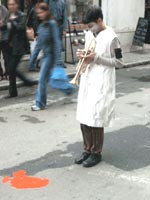Observing "Observart" without a definition of art
Give most artists the time of day and they’ll freely pass the hours with standpoints and philosophies mysteriously incorporated in their art. From my personal point of view some of those philosophies – mostly personified ego trips, might as well stay hidden.
As if the written word was supposed to replace the obvious of a good picture. Then again, as in most cases, the designated work probably never achieves that level of self-explanation, which it should - regardless of artist intension. An artist might argue otherwise: In the beginning he had an idea - and that’s what the painting is supposed to be of. The artist knows it, because, of course, he put it there himself!
The role of the journalist is also prescribed in that glamorous scheme. He’s often considered an analyst of meanings, the intrepid champion of misunderstood art, who will make the artist known in local news stories, when in fact the basics of market strategies were never really applied, much less understood.
But such matters seemed of little concern to a young group of artists and students I recently ran into at a street performance in the Romanian capital of Transylvania, Cluj-Napoca. The way they were observing the action of the performance as well as their concept of the observed action was interesting. They dubbed their activity Observart.

“Is Observart a movement, a transitory situation, a passing event”, I inquired? “Never mind”, I thought. Despite its fleeting definition I was soon to learn that Observart was nevertheless something worth taking a closer look at. The stipulated concept defies previous art logic, bringing to mind the immediacy involved in art movements such as Fluxus, Happenings, or even Dada. “So let’s not judge too prematurely”, I thought, but went about scrutinizing it’s alleged means of existence, attempting to learn why it arose in the first place and what its essence entailed.
The art of observing art systems cannot be divorced from the art of observing art systems to paraphrase one model of the Observart system, Heinz von Foerster (cybernetics). That’s because people observe, which directly relates with a person’s own subjective limit of what he can know – ones self. While people who observe are apt to make useful descriptions, most will appreciate descriptions that include the observer in the description. Descriptions as art chooses to see may be quite different from more conventional views used by people in e.g. business, industry or politics.
For example, some genre forms of painting throughout Cluj-Napoca, Romania up until 1989 were created on the presumption that knowledge i.e. tradition is a commodity that can be stored inside a picture, and that the application of such stored knowledge to the real world constitutes a form of aesthetics. Only within such a "realist" view of the world do, for example, semantic networks and rule-based expert systems appear to be a road-plan for the dissemination of art culture e.g. art cultures deemed politically correct by a select few.
By contrast the theory behind Observart appears to have originated from a constructivist view of the world where objectivity derives from shared agreement about meaning, and where cultural distinctions (or intelligence for that matter) is an attribute of an interaction rather than a commodity stored in a picture. These differences are not merely semantic in character, but rather determine fundamentally the source and direction of research performed from an observer’s point of view, versus a stance based on e.g. the meaning of an art object.

One influence on the group’s serious involvement can be attributed to Francesco Valera and Humberto Maturana, two Chilean biologists who recast the concepts of "language" and "living system" in terms of autopoiesis. Thus art in the since of Observart is thus not a process of accumulation of representations of the environment in e.g. paintings, it is a continuous process of transformation of behavior through continuous change in the capacity of the observer to process it and synthesize it. Recall does not depend on the indefinite retention of a structural invariant that represents an entity (an idea, image or symbol), but on the functional ability of the system to create, when certain recurrent demands are given, a behavior that satisfies the recurrent demands or that the observer would class as a reenacting of a previous one. Such is the nature of Observat that the viewer stays in his own picture (scope of observation), and reacts accordingly for as long as he wishes to stay in the game, the ongoing game of art of course.
Cort Vallis 6/2003,
Journalist, Cluj-Napoca, Romania